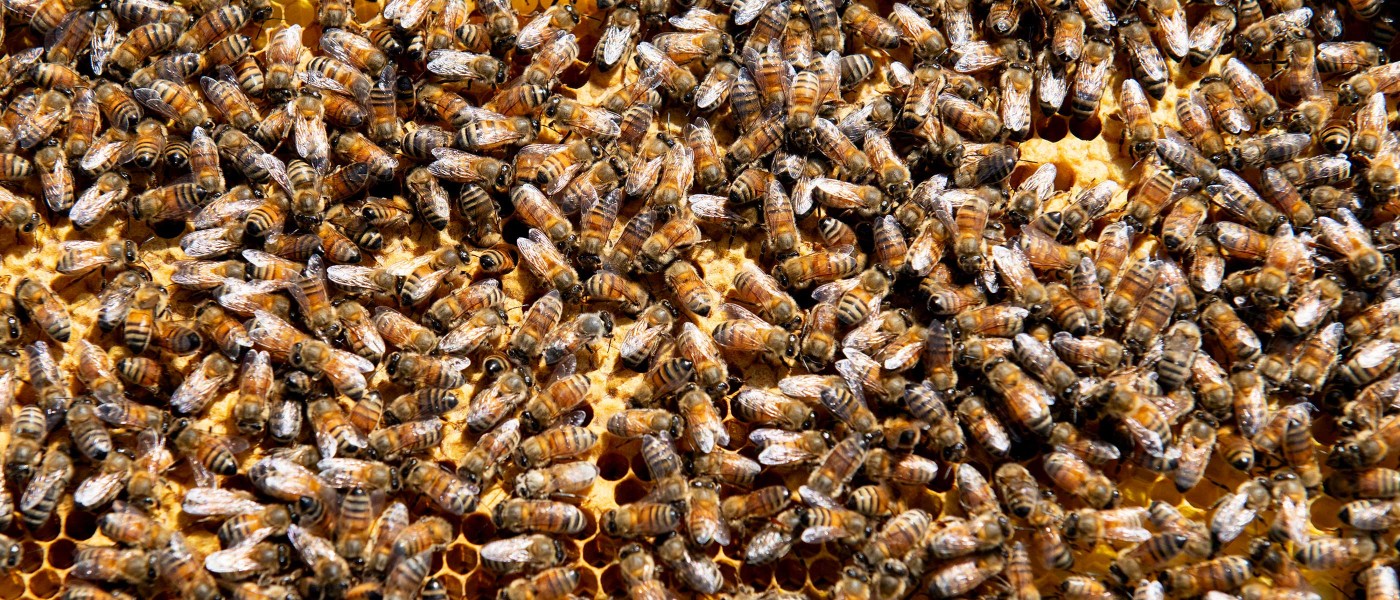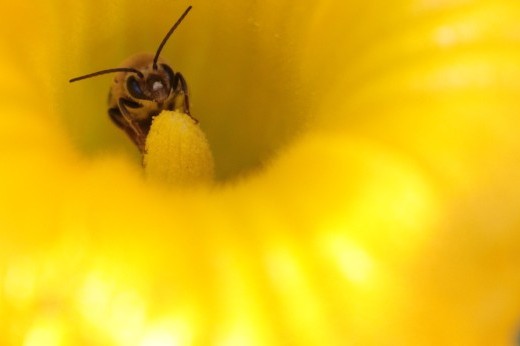Quick: What’s the first word that pops into your mind when you hear “bee?”
After “pollination,” people often say things like “hive,” “honey,” and “queen bee.” Those words all describe honey bees, darlings of media and agriculture. But honey bees, fascinating though they are, aren’t the best brand ambassador for bees.

Why? First of all, honey bee social structure is absolutely not standard bee operating procedure.
A single queen honey bee rules over a hive, served by tens of thousands of her sterile worker daughters. They communicate in a language made of dancing and chemicals. They extrude wax from their abdomens and shape it into perfect hexagonal combs. Worker bees navigate miles around their hive using the geometry of polarized light angles. Yet of the 20,000 known species of bees in the world, only seven (0.0003%) are honey bees.
Second, honey bees are not native to the Americas. The Western honey bee (Apis mellifera) is a domesticated species of livestock that arrived with Europeans in the 1600s. We harvest the products of their bodies just like other herds. We provide them with little barns, oversee their breeding, and medicate them.
As an introduced, domesticated species, it’s often said that keeping honey bees to “save the bees” is a bit like keeping chickens to help conserve songbirds.
The 19,993 other kinds of bees
By using honey bees as our default model of what a bee is, we miss out on the amazing diversity and beauty of not-honey bees.
In North America, there are around 3,600 known species of wild native bees. Over 90 percent are solitary bees that do not live in hives. They don’t make honey. They don’t make beeswax. Many of these bees don’t sting, or even have a stinger. Their life cycle is radically different from that of a honey bee.

New York State is home to 450 different species of wild bees, most of which you’ve probably never heard of. They have delightful names like “silver-tailed petalcutter” and “spring beauty mining bee.” For these two solitary bees, one single mom bee does all the work of creating a nest and provisioning her larvae.
Petalcutter bees (Megachile montivaga) carefully cut tiny blankets from flowers, then nestle their petal-swaddled babies in hollow stems. Spring beauty mining bees (Andrena erigeniae) only gather pink pollen from spring beauty flowers (Claytonia virginica), earning them the nickname “Barbie bee.” Many wild bees are specialists, and need specific flowers or habitats to survive.

The biggest difference between honey bees and solitary bees is scale. Queen honey bees can live up to seven years and lay 2,000 eggs in a single day. Female solitary bees live one year and lay 10–30 eggs in their entire lives. Petalcutter and mining bee mothers will never see their children; they work to prepare a nest, provision it with all the food needed to grow bee larvae, lay their eggs, and die.
Honey bees can’t feed us by themselves
Our interest in bees is closely linked to what they do for us. We need to “save the bees” to save our food supply. You’ve probably heard that a third of food crops depend on pollinators—but wild bees are part of that calculation.

Honey bees often get all the credit for crop pollination, but when wild bees are present, fruit production increases. And for crops that evolved in the Americas—squash, blueberries, tomatoes—it’s native bees that evolved with those plants that do the job best: squash bees, blueberry bees, and bumble bees.
Beyond crop pollination, native bees play a critical role in their ecosystems. While honey bees occur in tremendous numbers, they aren’t the most common bee visitors to North American non-crop plants. And it’s those plants and trees that produce seeds and fruits that feed birds and other wildlife, and bring us joy with their beautiful flowers and scents.
Saving the (wild) bees
Despite a “curiously persistent” belief that honey bees are going extinct, they are not. Guess who might be? A 2022 pollinator survey found that many of New York’s native bees are at risk of disappearance. The majority of these are solitary, ground-nesting bees. Wild bees are very different from honey bees, and need different conservation strategies.


Research suggests honey bees affect wild bee diversity through competition. Just one honey bee hive collects enough pollen over the summer to support the development of 100,000 solitary bees. Honey bees also struggle with diseases, which can be shared with wild bees.
Both honey bees and native bees face challenges in our human-altered landscapes (although honey bees at least have rent-controlled housing). One way to help all bees—in addition to supporting pollinator-friendly legislation—is to create habitat: Plant flowers for food, avoid pesticides, and provide shelter. Creating native bee habitat can improve life for a wide variety of bees, and also support non-bee pollinators like flower flies, beetles, and butterflies.

Research on urban wild bee diversity is encouraging—you don’t need huge tracts of land to successfully support bees. Balcony pots, small gardens, or neighborhood plantings all seem to help. Choosing native flowering species that bloom at different times helps offer bees a year-round food supply. (Make sure that new plants and seeds weren’t treated with insect-killing compounds.)
Providing nesting sites for solitary bees doesn’t take much space either. Leaving some bare ground and avoiding thick layers of mulch helps many of these bees thrive. Letting stems stand through winter helps stem-nesting bees inside make it to spring.
For these tiny animals, small changes we make can have a big positive impact.
To learn more about supporting native bees, check out the following resources:
- Nesting and overwintering habitat fact sheet from the Xerces Society for Invertebrate Conservation
- Pollinator-friendly native plant lists and a guide to buying bee-safe plants from the Xerces Society
- Article on making your garden a haven for insect diversity from Brooklyn Botanic Garden



